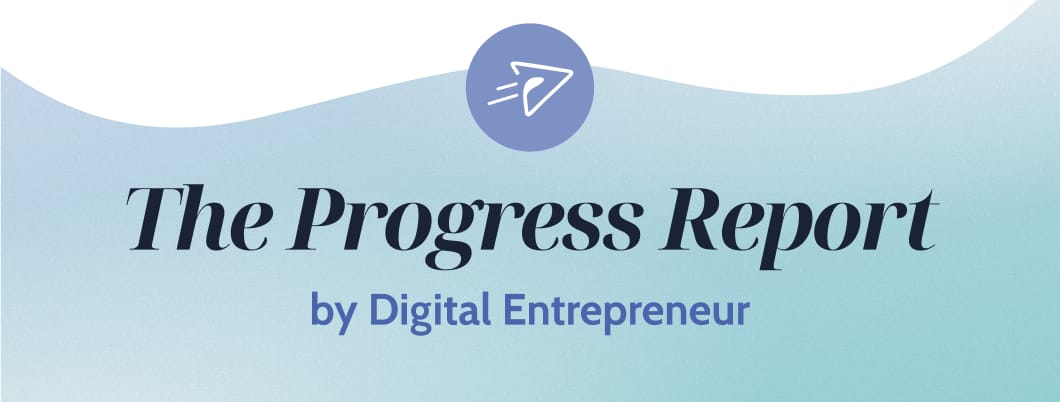
July 3, 2025
In partnership with

You have the same 24 hours as everyone else.
So why does it feel like some entrepreneurs build thriving businesses, while others get stuck in the “figuring it out” phase?
The difference isn't talent, luck or resources. It's how they think about time.
Most people optimize for return on investment. But in the early days of entrepreneurship, your ROI is often terrible. You'll rarely get compensated as well as a normal job would pay you.
Successful founders optimize for something different: Return on Time (ROT).
Instead of exclusively optimizing for revenue, they merely use revenue as an indicator that they’re working on the right thing. They ask “Is this the best use of my time to get where I want to go?”
Every task gets evaluated against three simple criteria:
Does it move me forward?
Do I want to be doing it?
Am I good at it?
The change seems small, but it’s a mental shift that can clarify what’s important to you, right away.
In this newsletter:
How successful founders think about time as their most valuable asset
An audit to map your activities against what actually moves you forward
Sponsored
Making “just you” more than enough for your business
Every week, I aim to give you tips and inspiration for growing your business without bloating your payroll. But sometimes, having it all in one place works even better.
That's exactly what HubSpot and The Hustle have done here. This comprehensive guide covers the solopreneur essentials I talk about regularly: smart automation, strategic partnerships, lean operations and sustainable growth.
They just happened to organize into a step-by-step roadmap before I did 🙄
Whether you've been reading since the beginning or are newer here, it's a solid resource to bookmark and reference as you build.
Weekly Insight

When Pieter Levels was building Remote OK, he faced a problem that stumps most early-stage entrepreneurs: should he add a complex job matching algorithm or focus on improving the basic job posting flow?
Option A, complex algo: a lot more work required, but results in proprietary software
Option B, basic flow improvements: much less intensive, but potentially much less important
Rather than get others’ opinions on the matter, Levels tried to figure out the option that would be best for him. He asked himself: “Which option gives me the highest return on time invested?”
The algorithm would take months to build, require ongoing maintenance and might not even improve user satisfaction. The posting flow improvements could be done in a weekend and would immediately impact every user's experience.
He chose the posting flow, and it paid off immediately.
More companies started posting jobs because the process was simple. More jobseekers returned because they could find opportunities faster.
The simple improvement created a virtuous cycle that helped the platform grow organically.
This single weekend of work, focused on the right problem, had more impact than months of complex development would have achieved. By consistently making these ROT-driven decisions, Levels built Remote OK into a platform generating over $2 million annually.
This is Return on Time thinking at its core. While most entrepreneurs get paralyzed by endless possibilities, successful founders use time as their primary decision-making filter.
They don't just ask “Will this make money?” They ask “Is this the best use of my limited hours?”
Consider the typical entrepreneur's day:
answering emails
attending networking events
perfecting website copy
researching competitors
optimizing social media profiles
All “important” work. But an ROT thinker would ask: which of these activities actually moves the business forward? By how much?
The ROT framework forces brutal honesty about opportunity cost. Every yes to one project is a no to something else. Every hour spent on low-impact tasks is an hour not spent on high-leverage activities that could transform the business.
The entrepreneurs who escape the “always busy, never progressing” trap share this trait: they've learned to think in terms of time leverage, not time spent.
📚 Related Reading
How narrowing your task list can enhance productivity by Digital Entrepreneur’s team | How to select “precision tasking” over multitasking, including the 3/3/3 framework and other prioritization strategies.
11 strategies to conquer time management and boost productivity by John Rampton | Practical frameworks including time-blocking and SMART goals to help entrepreneurs maximize their daily productivity.
Top prioritization frameworks for better decision-making by Sudarshan Somanathan | Evidence-based methods for choosing which tasks deserve your limited time and resources.
The difference between successful people and really successful people is that really successful people say no to almost everything.
Intent to Action
Strategy requires saying no to good opportunities so you can say yes to great ones.
It’ll hurt in the moment, but once you’ve learned to think in terms of Return On Time, it becomes easier.
Here's how to implement ROT thinking:
Step 1: Model out your time
Take a pie chart and divide it into 24 hours. Map out exactly how you spend your day:
Sleep (hopefully 7–8 hours)
Family and personal time
Work
Pay attention to how you feel seeing the proportions against one another. If your family and personal time is nonexistent, start setting harder boundaries, or you’ll burn yourself the heck out.
Now here's the crucial part: within your work hours, create a second pie chart showing:
Revenue-generating activities (sales calls, client delivery, product development)
Administrative tasks (emails, scheduling, invoicing)
Learning and planning (research, strategy sessions, skill development)
“Busy work” (absently scrolling social media, unnecessary meetings, perfectionism)
Most folks I do this exercise with are shocked to discover they spend less than 30% of their work time on activities that actually generate revenue or move the business forward.
Be brutally honest here. Track a typical day using your phone's screen time data, or simply set a timer every hour to jot down what you just did. Don't estimate or idealize. Use real data.
It’s going to feel uncomfortable. Maybe even like a waste of time. But do it. 95% of the time, we write down how we wish we were spending our hours, rather than the reality.
Only reality is going to help, here.
Step 2: The ROT evaluation
For each slice of your work pie, ask:
Does this directly contribute to revenue or business growth?
Could someone else do this for less than my hourly rate?
What would happen if I stopped doing this entirely?
Rate each activity on a 1–10 ROT scale:
8–10: High ROT (sales conversations, product creation, strategic partnerships)
5–7: Medium ROT (necessary admin, team management, customer support)
1–4: Low ROT (checking email, scrolling social media, “research” that never leads to action)
Red flag activities include:
Checking email more than 3 times per day
Attending meetings without clear agendas or outcomes
Perfectionism (aka a fear of failure) disguised as “quality control”
Learning new skills that don't directly impact your current business goals
Administrative tasks that could be automated or delegated for under $25/hour
Step 3: The 1% shift
Don't try to overhaul everything at once. Instead, identify just 1% of your work time (about 20 minutes in a standard work day) that you can shift from low-ROT to high-ROT activities.
Specific swaps to try this week:
20 fewer minutes answering non-urgent emails = 20 more minutes prospecting for new clients
15 minutes less social media = 15 minutes improving your sales process
30 minutes fewer “research” tasks = 30 minutes reaching out to potential partners
Make it concrete: If you currently spend 2 hours daily on administrative tasks, can you batch them into one 90-minute block? Use the saved 30 minutes for outreach, product development or marketing.
Tools to help:
Use Calendly to eliminate back-and-forth scheduling
Set up Zapier automations for repetitive tasks
Batch similar activities (all calls on Tuesday/Thursday, all admin on Friday mornings)
Use the 2-Minute Rule: if it takes less than 2 minutes, do it now. If more, schedule or delegate it.
Step 4: Weekly ROT reviews
Every Friday, spend 10 minutes reviewing your time allocation from the week.
From there, create a simple tracking sheet with three columns:
High ROT wins: Which activities gave me the biggest return this week?
Time drains: What consumed time without clear value?
Next week's focus: Based on this data, where will I invest my best hours?
And, just as you would when trying to gain or lose weight, start tracking. The specific metrics you track will depend on your goals, but I always find these helpful:
Hours spent on revenue-generating activities
Number of low-ROT activities you eliminated or delegated
New systems or processes you implemented to save future time
From there, you can start building longer-term goals and find sticking points to get external help with. For example:
What's my average hourly rate for time spent on high-ROT activities?
Which low-ROT activities am I still doing that I could eliminate?
What skills or systems would give me the biggest time leverage next month?
As with any of the changes I recommend, the goal isn't perfection. It's awareness, followed by small, consistent improvements in how you leverage your time and energy.
After four weeks of this practice, most entrepreneurs find they've reclaimed 5–10 hours per week for high-impact work, often while reducing their overall stress levels.
If you’re trying this out and get stuck, reach out to me. Helping people get unstuck makes me really happy (in case you couldn’t tell based on this whole newsletter, lol).
Closing Thought
The hardest part about ROT thinking isn't the math. It's admitting that half the stuff you do every day doesn't actually matter.
Most of us cling to busy work because it feels productive. Answering emails gives you a little dopamine hit. Attending meetings makes you feel important. And when you’re doing things on your own… those things help.
But they don’t drive results.
Your business doesn't care how busy you are. It only cares about results.
The entrepreneurs who escape the “always working, never progressing” trap aren't superhuman. They just got ruthless about protecting their time from everything that doesn't move the needle.
If you’re hesitant, start small. Pick one low-ROT activity and eliminate it, this week. Just one. See how it feels to reclaim even 20 minutes, and you’ll be hooked.
Next week, I’m getting married. Woohoo!
But don’t worry, I’ll be in your inbox anyway (thank you, newsletter scheduling system—to deliver the goods on classifying yourself. What’s the difference between an entrepreneur and a small business owner, when they both started the business? Which one are you?
See you then.

